There are a ton of sales strategies out there to help close deals. But my favorite of all sales strategies has to be the three-tiered pricing strategy.
In this article, you’ll discover the benefits of a tiered pricing model, what its primary advantages are, why it’s crucial to understand it, and some tips on how to implement price tiering in order to get your deals closed more easily and boost sales.
So before you create tiered pricing, check this complete guide.
What is Three-Tiered Pricing?
A three-tiered pricing model is a business method of laying out three different service solutions to your customers at three different pricing points, no matter if you use fixed pricing, value pricing or a volume pricing model.
So instead of showing a potential customer or customers one level of service with one pricing tier (or with two tiers), you show them three levels of service or three tiers.
This works especially well with a productized service offering, where you bundle a variety of services, additional features, and forms of value into one tier or a monthly fixed-price subscription.
Like this example from Pilot:

The three-tiered pricing strategies are also known by many different other names, including choices pricing, Goldilocks pricing, the good-better-best pricing strategy, and the gold-silver-bronze pricing method.
In a business, there are different pricing tiers but either way, all of these terms mean the same thing.
Now let’s look at why we would even implement this tiered pricing sales strategy in the first place.
The Truth About Sales

First off, in our profession, the word “selling” or sales” seems to be an ugly word.
It’s not.
Any business in the world sells something. So does your firm.
Second, in order to sell something and get more customers for your business, you need to understand what makes your target market tick so that a customer buys. This is where understanding psychology is important.
Sales in accounting are not just about understanding your client’s business. It’s about understanding the people behind it and what’s in their brains.
You need to understand their pains, their challenges, their sweet spot, the different buyer personas, and their ideal outcomes. This will also help you give an effective advisory or consultation service.
And from there, you can craft a pricing offer that solves these problems and improves your customers’ business situation.
Sales are essentially about performing a needs analysis on your prospective customers, understanding their situation, and then communicating an offer. From there you’ll surely be in a better position to land happy customers.
All we are trying to do in sales is bridge the communication gap between what you offer and what your potential customers are looking for.
Easier said than done since it’s incredibly hard to get into your prospect’s heads.
This is where a three-tiered pricing strategy can help.
Why Implement Three-Tiered Pricing?
I think there are three main reasons why I’m a big fan of the three-tiered pricing model rather than a one-tier pricing model and they both have to do with how our brains are wired.
Avoids “Take it Or Leave It”
When you propose your services in a one option approach, it becomes a ‘take it or leave it” decision for your prospective client.
When you present multiple options for pricing to your customer, the thought process for your prospect becomes much different.
It moves from “take it or leave it” to “which option do I like best”.
This changes the entire dynamic of the conversation that follows and is one of the main benefits of tiered pricing.
It also makes your business sales process a much gentler approach and shows that you’re on their side to work with them to try and find something that suits them.
Hitting the Bulls-Eye is Impossible

In a firm, tiered pricing differs from a fixed pricing model; how do you know the precise amount someone is prepared to pay?
How do you set the right pricing tiers for your customers?
Well, you could read my guide to pricing accounting services to help you develop a price, but unfortunately, you’ll still never hit the nail on the head.
That’s because it’s impossible. You’ll never know exactly what a potential customer is willing to pay.
Options pricing structure helps you get around this and is another one of the big benefits of tiered pricing.
Instead of just showing one option at one price (which may or may not be the wrong price), you can show a wider range of different price points, or three tiers.
The wider the range of the pricing you can offer to a prospective customer, the easier it will be to hit the “bulls-eye” to make sure that it gives more value and you can strike a deal that both parties are happy with.
You Can Often Land Clients at Higher Priced Packages
With the right business strategies (which I’ll touch on below), converting leads becomes easier since you can often land prospective customers or get a wider audience on a higher-priced plan (ie. customers pay you more).
This has to do with the power of three options, or tiered pricing.
There’s something in our brains that likes three options compared to two options or four options, for example.
And when you lay out three options for customers, studies show that 66% of people will select the middle option, 23% will select the low option and 11% will pick the high option.
By this logic, your business can get 76% on options above your basic service level, which is your next tier.
Many companies already use this type of method.
Why do you think most companies like Apple use different tiers?
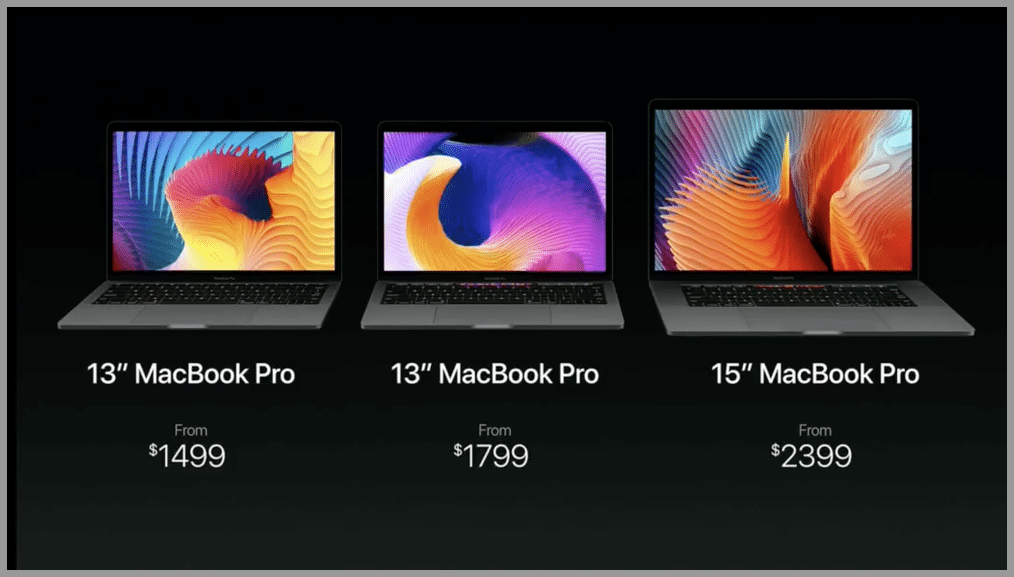
It’s no wonder why this method is called the Goldilocks method: The first option is the standard tier or the lower price, the next tier or the middle option has different features too and is just right, and the last option is the premium tier or premium plan.
How to Implement Three-Tiered Pricing
Below are a few tiered pricing examples that have three different pricing levels, in order to apply a three-tiered pricing model sales approach.
1) Creating Your Options
After you conduct a needs analysis of your prospective client, it’s time to put different pricing-tiered options together.
Your basic option will be called your baseline option. This is the most basic service level that you want to offer which will be at a relatively low price compared to the other options.
Your top option will be your super-premium tier or higher tier and will dictate a high price.
And the middle option will sit nicely between the two and will be the option that offers the best middle ground to your customers in terms of pricing, service, and cost.
2) Use Technology to Present Your Options
After you’ve put together your options, I highly recommend presenting these options via a call. In order to do so, you’ll need to use a good kind of accounting technology to present the pricing to your potential customer.
There are 3 alternatives that you could use:
Alternative 1 – A Virtual Whiteboard
Right now, an app called Miro is pretty popular to whiteboard all kinds of things. This means you could whiteboard your three-tiered options to present different tiers to prospects.
Here’s a really simple one I just setup:
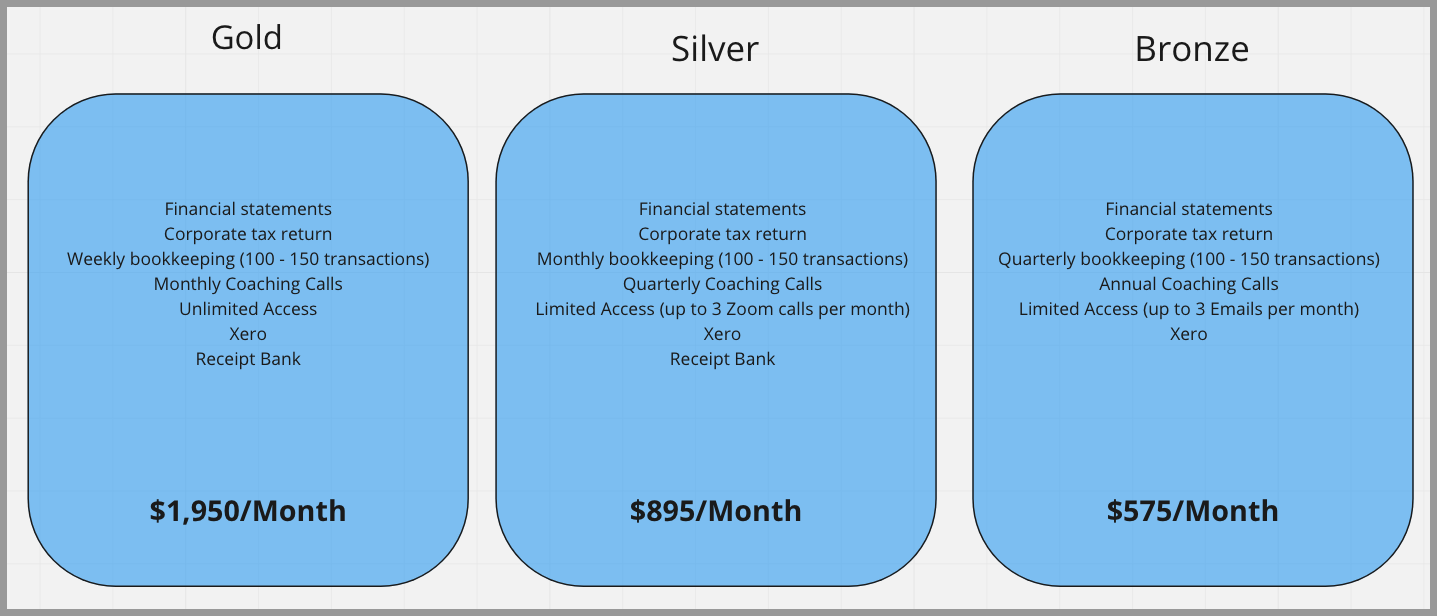
When I ran my firm, I was using something similar to this, but as you can see, you’ll want to ensure that the design looks a bit better for your tiered pricing, which is the main problem with these kinds of apps. On top of that, it can take a bit of time to put them together for each client when it comes to editing and formatting.
Lastly, once you have someone that agrees to a particular plan from your business, you have to get the corresponding option into your proposal software, which duplicates your efforts.
That being said, due to the lack of available technology options that support a three-tiered pricing structure, this is an option to consider.
Alternative 2 – Practice Ignition
I’ve been begging the Ignition (affiliate link) team for this feature ever since I became a user in 2013 and I’m so happy that it’s finally available!
For those who don’t know, Ignition is an app that helps you easily create proposals and engagement letters, automatically accept payments on accepted deals, and automate the creation of workflows that follow (ex: creating invoices in your accounting system, deploying workflows for your tasks, etc.).
Before their tiered pricing model feature became available, I was using a combination of alternative 1 above in combination with Ignition.
Now, this process has become much easier.
When you’re creating your proposal in Ignition, you’d start by including your pre-loaded services to create your Gold option, as I did here:
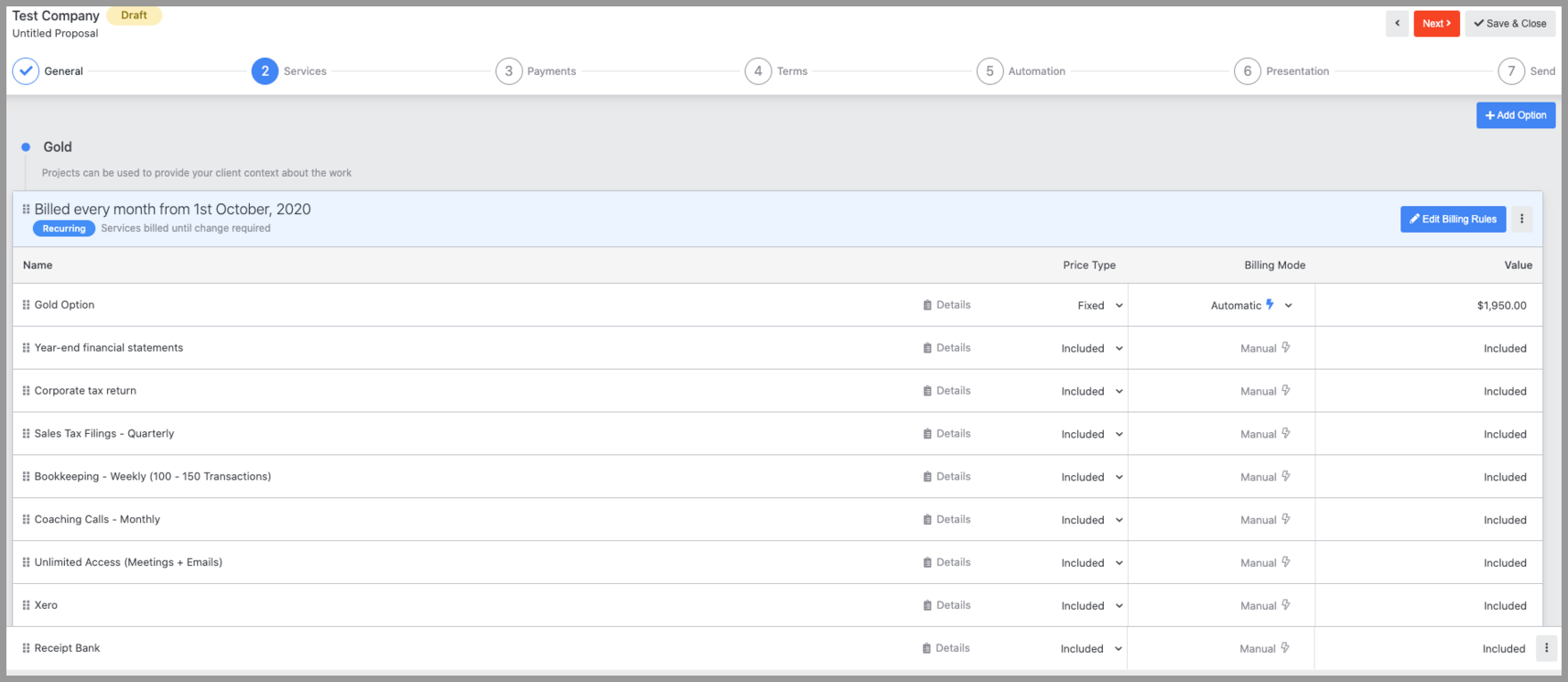
You’ll notice at the top right of the screen that there’s a button that says “Add Option”:

By clicking this, you can start adding your different tiered pricing strategy options, as I have done here:
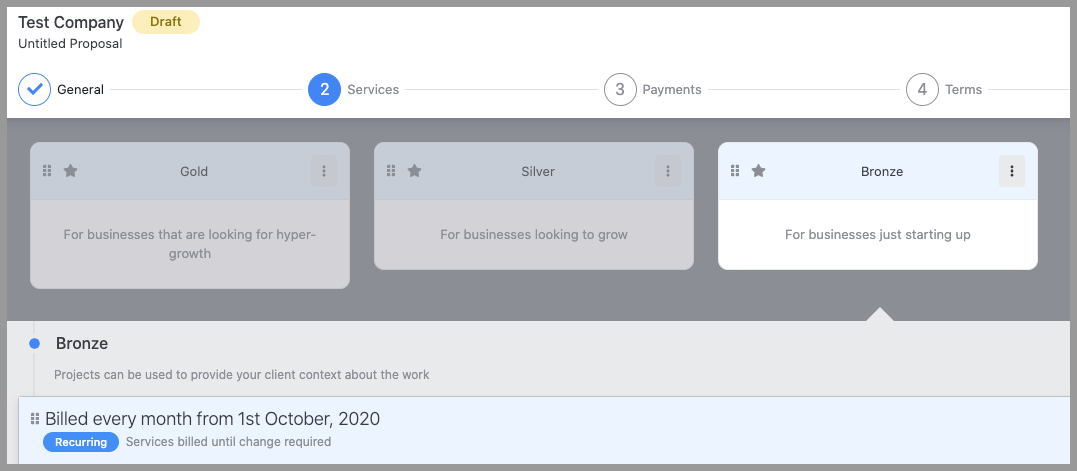
Once I create the tiered pricing in Ignition and follow the steps to complete the proposal, I’m able to preview what the customers will see on their end to select the option they like best immediately after the options are presented:
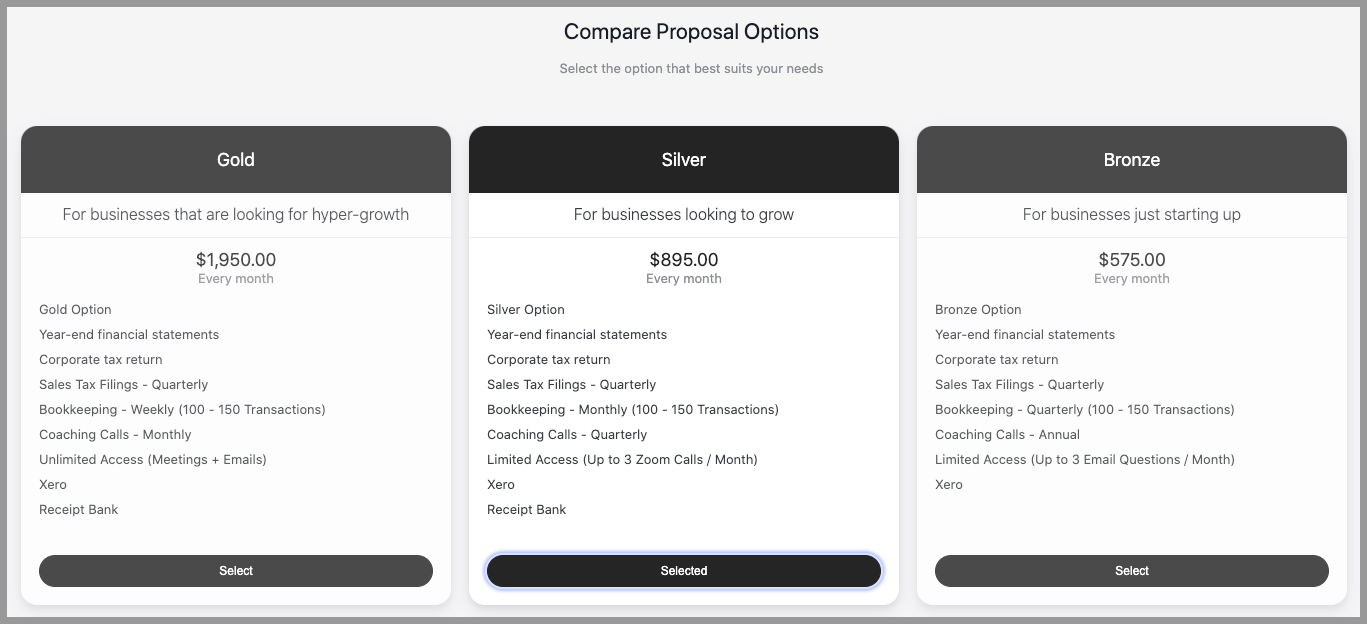
Compared to alternative 1, this is way slicker and far more integrated. The implication, in my opinion, is more closed deals in less time.
Alternative 3 – Excel to PDF
I hate to even write this as an option but I do see some people handling options pricing structure in this fashion, mostly because:
- It’s free
- There’s been a lack of alternatives available
Basically, you create your tiered pricing options in Excel, convert them to PDF and then present it to the client.
It’s not my favorite, but it’s an option for your business.
3) Utilize Price Anchoring
Notice in the above examples how I showed the gold option first? Also, notice how the pricing of the gold plan is significantly higher than the other two options?
There’s a reason for that and it’s called price anchoring.
There’s a bit of a shock value associated with immediately being hit with a high price. But after that, the potential customer becomes desensitized to the price of the other two options, making it easier to close the deal.
Side note: In Practice Ignition, you can “star” your preferred option, which very likely would be your middle option, to show it as “preferred”.
4) Differentiation is Key
The key to options pricing is the differentiation between your options. The more you can differentiate, the better offer you can present to your customers.
And this takes a bit of creativity.
For instance, look at the support options I provide here:

In this simple example, the gold option is unlimited, the silver option provides limited Zoom access while the bronze option just provides some basic email access.
And there are other ways to differentiate these pricing options.
I could say that the gold plan includes unlimited access to the entire team while the bronze plan or the basic tier included access to bookkeeper-level team members, for instance.
The more you can differentiate your tiers, the more powerful your three-tiered approach becomes.
5) Present Options Horizontally
The best way to present tiered pricing to customers is in a horizontal format. You can present them vertically, but it makes comparing options more difficult. The more friction you add to the process, the higher the chance you lose out on the deal.
And vice versa, the easier you make the sales process on your customer, the higher the chances of closing.
6) Try This Simple Phrase
After you present your options, ask the potential customers this very simple question:
“Which option do you want to start with?”
Here, you’re basically asking your prospective client to make a decision. So rather than an “I’ll think about it” response, your potential customer is actually going to tell you which option they like best to kick things into what’s hopefully an accepted proposal.
Over To You
Hopefully the above demonstrates a better understanding of price tiering and why I think the three-tiered pricing model is so powerful and how you can implement it yourself at a reasonable or even higher price to get more customers.
If you’re not convinced about three-tiered pricing for your business, you might want to check out what value pricing guru, Ron Baker, has to say about it at 38:15 of this podcast episode.
Tiered pricing works. I think the biggest takeaway of this article can be summarized in that sales and the entire process around it involves psychology and an understanding of the human brain. The more you understand a tiered pricing structure and different price points, the more deals you’ll be able to close with customers. The three-tiered pricing model is just one such strategy.





Ryan, Great Article!
Reading this I have just submitted my first proposal on Three-Tiered Pricing made in excel, let see how does it perform.
figures crossed.
Keep me posted.
Any other proposal software options for tiered pricing? Practice Ignition is a little pricey for small firm.
Nope, there’s not unfortunately. It’s worth the money imo.
Define small? I started using PI when my firm was expected to only have $100k gross in sales.
Thanks for this Blog Ryan!! I love it! I used CANVA to create my three-tiered pricing offer. Today I have my first sales call with it!!